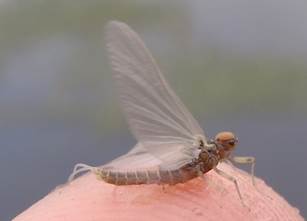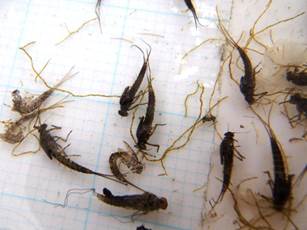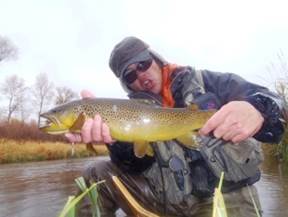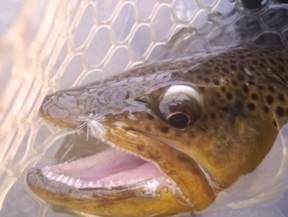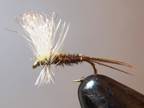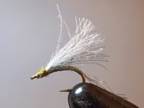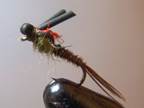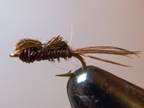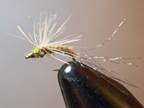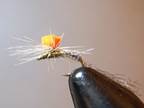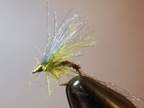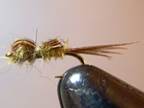LATE & EARLY SEASON FISHING AT DEPUY'S SPRING CREEK (part 3)
| Sysadmin Note |
|---|
| Part 2 can be found here |
PART 3: FALL ATTRACTION – 1
Two Attractions: When you are able to use your winter-pass that starts on October 15th, there are two big attractions at DePuy's.
- Blue-Winged-Olive (fall baetis, hereafter BWO) is the last major hatch in this area.
- Brown trout are coming into creek from the Yellowstone River to spawn, followed by rainbow trout. Some of them (both species) are really big and could be a trophy for the year.
In this part, I focus on fall BWO hatch.
Hatch: Fall BWO can be seen from September around Paradise Valley and Yellowstone National Park, so it's safe to say that BWO hatch is in full-swing at DePuy's when the winter-rate starts on October 15th. It usually lasts till middle of November. Only one limiting factor is the infamous SW gusts through Paradise Valley. I don't mind fishing in those windy days as I know trout are in the creek but gusts seem to blow all the insects away to Canada. Along with terrible waves at most parts of creek, it's hard to have trout see your dry-flies. When the wind is calm one can see BWO spinners in the morning. They are remnants from previous days. The BWO hatch starts from 12:30 to 1:00pm and trout will rise. The typically hatch will last for two hours. Unfortunately the BWO hatch can be stronger on overcast, rainy, or even snowy afternoons. Those conditions are barely tolerable for anglers but that's when big trout that are measured in pounds and not inches join the rising group of trout. If you encounter this kind of days, that can be some of the best dry-fly and match-the-hatch fishing of the year!!
|
|
Fall BWO: sizes 20 & 22 are most common (plus sizes 18 & 24) |
One of the stomach samples. This trout was exclusively feeding on ascending nymphs with split wing-cases. |
Basic Technique: The most important aspect when casting dry-flies at spring creeks is "the angle of presentation". By applying the reach and down and across cast without mending, one can show the flies first to trout, not tippets, and without drag. Angle and distance can be adjusted by taking a step rather than handling more line or disturbing the water by mending. This idea corresponds to the size of the tippet. Since we are showing our flies first, does the size of the tippet really matter? Some may argue even 6x is too bulky at DePuy's, but if trout could detect a 6x tippet, they must have been able to detect hook-points and pinched barbs on our flies. Trout detect our flies as "fake" and decide to pass them up because of drag and/or wrong patterns (also trout may recognize our presence and some other factors). This is why mastering "the angle of presentation" is very important. Fishing for fall BWO hatches, on bright sunny days, I tie my first fly on 5x then trail my second fly with a piece of 6x. On windy days (which is norm in Paradise Valley), I go with 4x then 5x (first and second fly, respectively). Besides wind, if the weather turns overcast (cloudy, rainy, snowy, or mix of all), I stick with 4x and 5x. In one wet afternoon, I could keep casting to really tight spots (a few inches off over-hanging grasses), hauling trout in quickly, and fishing more simply because I was with 4x and 5x. My best dry-fly caught trout ever was on size 20 tied on 4x tippet!
|
|
"20-20" = 20-incher on size 20 dry-fly!! |
Size 20 Pheasant Tail Mayfly Cripple tied on 4x. |
Flies: I almost always fish with two flies. That can be: two dry-flies (duns and emerger patterns, one is more visible than the other); or one dry-fly (parachute or other visible type) + nymph patterns (for various depths). Here are some of my most effective patterns.
|
|
|
|
Pheasant Tail Mayfly Cripple – Yamamoto's |
CDC Dun |
Winged Victory Nymph – Yamamoto's |
Sawyer PT (Master Angler Version) |
My own design is great success at DePuy's. On overcast day, synthetic wings are very visible and dry quickly. CDC fibers can be used for wings too. |
This classic pattern is still one of most important go-to flies at DePuy's. |
My intention is to imitate emerging/ascending nymphs of which wings are protruding with cases split. Look neat eyes!! See the stomach sample picture above. |
One can't go fishing without this all-time favorite fly. Tom modified the tying procedure of original Sawyer by using thread, which makes mass-production much easier. |
|
|
|
|
Paraloop Emerger/Cripple |
Foam Post Parachute – BWO |
Double CDC Emerger – Yamamoto's |
Turkey Biot Nymph |
This fly shows different silhouette to trout due to Paraloop. |
One can't go fishing without parachute. It sits low on the surface and can represent dun, emerger, and spinner. |
I fish this fly solely depending on floatation of CDC, no grease. Of course I will dry it later but I want it to sink a bit in the surface. |
A totally unweighted nymph is very important when trout are taking ascending nymphs. It should be fished behind visible dun imitations. Let it sink by its own weight. Dropper tippet can be greased. |
These are just examples. I suggest keeping many BWO patterns available to you in your boxes. By this time of the year, the water level is low (as aquatic weed beds degenerate) and trout have experienced all kinds of flies and tactics, i.e., selective and wary. This situation demands the best out of skilled anglers at DePuy's, which is always technical and challenging in its own right. So one can't have enough fly patterns for fall BWO. As my list notes, BWO's are not always olive. They can come with light olive and Adams gray.
(NOTE: Also refer to author's earlier articles "BWO Happy-Hour, Waterloo, and Solution".)
Satoshi Yamamoto - Livingston, MT
Blog @ https://leftyangler.blogspot.com
Japanese Blog @ https://leftyanglerjpned.blogspot.com
Fly Sales Online Catalogue @ https://leftytyer.blogspot.com
| Sysadmin Note |
|---|
| Part 4 can be found here |

